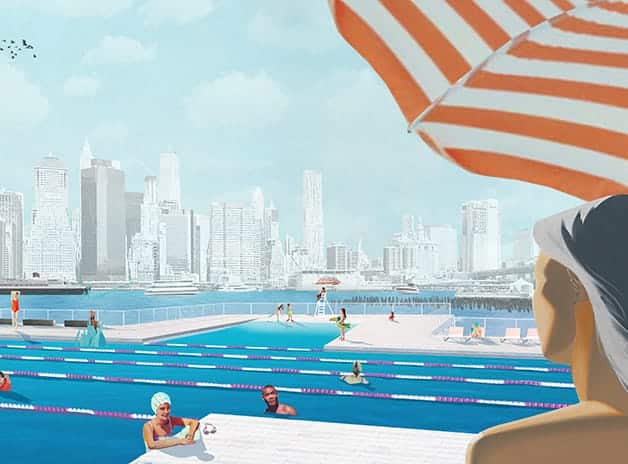A floating swimming pool in the heart of New York is one step closer to becoming a reality. It’s not a utopian fantasy dreamt up by visionary urbanists, nor a digital rendering lost in a forgotten folder at City Hall. + Pool—yes, with the symbol—is a bold public design project that began more than a decade ago, and after years of delays, redesigns, and regulatory hurdles, it is finally approaching its first real test in open water.
A twenty-meter prototype has been completed at Bollinger Shipyards in Mississippi and is scheduled to be transported by sea to New York in the spring of 2026, navigating around Florida and up the Atlantic coast. Once in the city, the structure will undergo inspection by public health agencies. Only if it passes will construction of the full-scale version be authorized, which is four times larger. The final pool is designed to float just off Pier 35, nestled between the Manhattan and Brooklyn Bridges.
What passersby will see is not a traditional structure but an unusual cross-shaped form hovering just above the water’s surface. It will be accessible via a walkway and open to swimmers who will immerse themselves not in chlorinated or treated water, but in water drawn directly from the river, which passes through a patented, chemical-free filtration system, and then returned into the current. The pool will function in a continuous loop, filtering and cycling river water in real time. Its designers estimate it will process up to one million gallons per day. But beyond its technical ambition, the project carries symbolic weight: it seeks to reestablish New Yorkers’ physical connection with the waterways that surround them, without fear or stigma.
The idea itself is not new. In the late 19th century, New York was home to more than a dozen floating public bathhouses, serving hundreds of thousands of residents each summer. That tradition ended with the rise of industrial pollution, which turned the city’s rivers into hazards rather than public assets. + Pool proposes to restore that relationship with a modular design that can adapt into an Olympic-length lap pool, a shallow wading area for children, a recreational lounge, or a space for public swim instruction. Depending on the day and configuration, it could be used for sport, leisure, or learning—always in contact with the living river below.
The concept originated in 2010 from a collective of independent designers and architects. It gained swift attention from the public and press, but the path through city agencies, environmental review boards, and funding processes was long and arduous. Securing permits, raising capital, and adapting the structure to meet both civic and ecological standards has taken more than a decade. Now, with the prototype built and in motion, the transition from vision to reality finally appears within reach.
“This pool is the result of civic collaboration,” said Kara Meyer, the project’s managing director. “It’s what New York does best—uniting public agencies, private citizens, designers, and advocates to build something that didn’t exist before.”
+Pool is a feat of hydraulic engineering, as well as a form of urban installation—a tangible meditation on how city dwellers might live alongside their environment, rather than apart from it. Its filtered water, adaptable geometry, and emphasis on public access represent more than architectural innovation; they reflect a deeper reimagining of what it means to inhabit the contemporary city—physically, socially, and ecologically.










